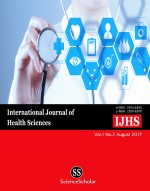Implementation of clinical decision support systems in emergency settings: Enhancing interdisciplinary practice among nurses and pharmacists
Keywords:
Clinical Decision Support Systems, interdisciplinary collaboration, patient history, emergency department, healthcare professionalsAbstract
Background: Accurate patient history assessment is vital for effective diagnosis and treatment in healthcare settings. However, traditional methods often lead to fragmented information and missed clinical data, particularly in emergency departments (EDs), where time constraints are prevalent. Methods: This study reviews the implementation of Clinical Decision Support Systems (CDSS) in emergency settings, focusing on enhancing interdisciplinary collaboration among healthcare professionals, specifically nurses and pharmacists. A thorough literature review was conducted to evaluate existing CDSS models and their impact on patient history acquisition and communication. Results: The findings indicate that incorporating CDSS facilitates comprehensive data collection by promoting interprofessional collaboration. Studies showed that multidisciplinary teams, through improved communication and shared electronic health records, significantly reduced information gaps in patient histories. The integration of pharmacists and nurses in the history-taking process led to higher accuracy and completeness, with some studies reporting an 89% accuracy rate in medication histories collected by trained pharmacy technicians. Conclusion: The implementation of CDSS in emergency settings enhances the accuracy of patient history acquisition and fosters effective teamwork among healthcare providers. Interprofessional education and collaboration are essential for maximizing the benefits of CDSS, ultimately leading to improved patient outcomes.
Downloads
References
Sanders L. Every patient tells a story. New York: Broadway Books; 2009.
Hampton JR, Harrison MJ, Mitchell JR, Prichard JS, Seymour C. Relative contributions of history-taking, physical examination, and laboratory investigation to diagnosis and management of medical outpatients. Br Med J. 1975;2:486–489. DOI: https://doi.org/10.1136/bmj.2.5969.486
Audétat MC, Lubarsky S, Blais JG, Charlin B. Clinical Reasoning: Where Do We Stand on Identifying and Remediating Difficulties? CE. 2013;04:42–48. DOI: https://doi.org/10.4236/ce.2013.46A008
Chapman G, Sonnenberg F. Decision making in health care: theory, psychology, and applications. New York: Cambridge University Press; 2000.
Bordage G, Zacks R. The structure of medical knowledge in the memories of medical students and general practitioners: categories and prototypes. Med Educ. 1984;18:406–416. DOI: https://doi.org/10.1111/j.1365-2923.1984.tb01295.x
Yuan B, Wang M, Kushniruk AW, Peng J. Design of a computer-based learning environment to support diagnostic problem solving towards expertise development. Knowledge Management & E-Learning. 2016;8(4):540. DOI: https://doi.org/10.34105/j.kmel.2016.08.034
Greiner A, Knebel E. Health professions education: a bridge to quality. Washington, DC: National Academies Press; 2003. DOI: https://doi.org/10.1111/j.1945-1474.2004.tb00473.x
Kruse J. Overcoming barriers to interprofessional education: the example of the joint position statement of the Physician Assistant Education Association and the Society of Teachers of Family Medicine. Fam Med. 2012;44:586–588.
Vanderbilt AA, Isringhausen KT, Bonwell PB. Interprofessional education: the inclusion of dental hygiene in health care within the United States - a call to action. Adv Med Educ Pract. 2013;4:227–229. DOI: https://doi.org/10.2147/AMEP.S51962
Vanderbilt AA, Dail MD, Jaberi P. Reducing health disparities in underserved communities via interprofessional collaboration across health care professions. J Multidiscip Healthc. 2015;8:205–208. DOI: https://doi.org/10.2147/JMDH.S74129
Vanderwielen LM, Vanderbilt AA, Dumke EK, Do EK, Isringhausen KT, Wright MS, Enurah AS, Mayer SD, Bradner M. Improving public health through student-led interprofessional extracurricular education and collaboration: a conceptual framework. J Multidiscip Healthc. 2014;7:105–110. DOI: https://doi.org/10.2147/JMDH.S52019
Interprofessional Education Collaborative Expert Panel. Core competencies for interprofessional collaborative practice. Washington DC: Interprofessional Education Collaborative; May 2011
Liaison Committee on Medical Education. Accreditation Standards. 2015.
Accreditation Council for Pharmacy Education 2016 Standards. 2015.
Future of Nursing: Campaign for action (2014). Campaign for action: Campaign overview. 2015.
Harolds JA. Quality and safety in health care, Part VI: More on crossing the quality chasm. Clinical Nuclear Medicine. 2016 Jan 1;41(1):41-3. DOI: https://doi.org/10.1097/RLU.0000000000001012
Institute of Medicine. The future of nursing: focus on education. Washington, DC: National Academies of Sciences, 2010.
Vanderbilt AA, Jain S, Mayer SD, Gregory AA, Ryan MH, Bradner MK, Baugh RF. Clinical records organized and optimized for clinical integration and clinical decision making. International Journal of Medical Education. 2016;7:242. DOI: https://doi.org/10.5116/ijme.576a.fff4
Clinicians VA. Diagnostic Decision Making. DSM-5® Casebook and Treatment Guide for Child Mental Health. 2016 Jun 21:347.
Betsch C, Böhm R, Airhihenbuwa CO, Butler R, Chapman GB, Haase N, Herrmann B, Igarashi T, Kitayama S, Korn L, Nurm ÜK. Improving medical decision making and health promotion through culture-sensitive health communication: an agenda for science and practice. Medical Decision Making. 2016 Oct;36(7):811-33. DOI: https://doi.org/10.1177/0272989X15600434
Published
How to Cite
Issue
Section
Copyright (c) 2017 International journal of health sciences

This work is licensed under a Creative Commons Attribution-NonCommercial-NoDerivatives 4.0 International License.
Articles published in the International Journal of Health Sciences (IJHS) are available under Creative Commons Attribution Non-Commercial No Derivatives Licence (CC BY-NC-ND 4.0). Authors retain copyright in their work and grant IJHS right of first publication under CC BY-NC-ND 4.0. Users have the right to read, download, copy, distribute, print, search, or link to the full texts of articles in this journal, and to use them for any other lawful purpose.
Articles published in IJHS can be copied, communicated and shared in their published form for non-commercial purposes provided full attribution is given to the author and the journal. Authors are able to enter into separate, additional contractual arrangements for the non-exclusive distribution of the journal's published version of the work (e.g., post it to an institutional repository or publish it in a book), with an acknowledgment of its initial publication in this journal.
This copyright notice applies to articles published in IJHS volumes 4 onwards. Please read about the copyright notices for previous volumes under Journal History.
















